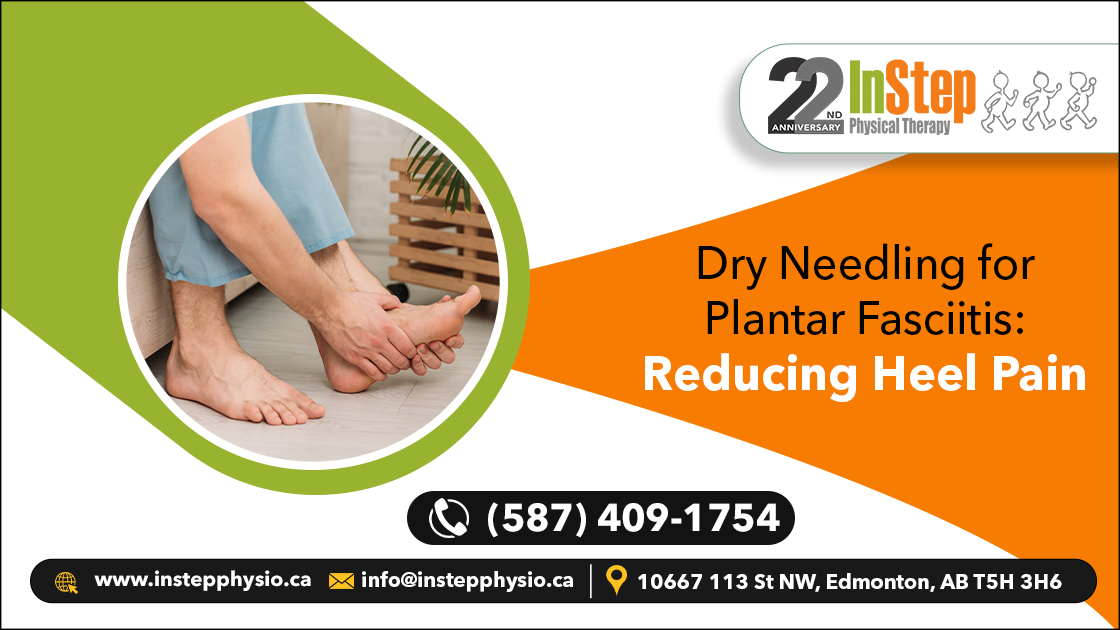Plantar fasciitis can cause significant discomfort in the heel. If you’re among the many struggling with this nagging discomfort, you might be wondering if there’s a way to alleviate it without resorting to invasive procedures. Dry needling for plantar fasciitis involves inserting thin needles into precise trigger points or tight bands of muscle in the foot and calf area. These trigger points are believed to contribute to the discomfort and inflammation associated with plantar fasciitis. Dry needling therapy Edmonton aims to release these trigger points and reduce muscle tension, which can alleviate pain and improve function.
What is Plantar Fasciitis?
It is a common foot condition marked by inflammation of the plantar fascia, a wide strip of tissue spanning from the plantar surface, linking the heel bone and the toes. It is usually caused by repetitive strain or excessive stress on the fascia, leading to micro-tears and irritation. People affected often experience sharp heel pain, particularly in the morning or after extended periods of standing or walking.
This condition can significantly affect daily life, causing discomfort with every step and limiting activities that involve weight-bearing on the affected foot. Symptoms may include heel pain that worsens with activity, stiffness and tenderness in the heel or arch of the foot, and sometimes swelling.
How Dry Needling is Used for Plantar Fasciitis in Reducing Heel Pain:
Dry needling for plantar fasciitis focuses on targeting specific trigger points and areas of tightness in the muscles and fascia associated with the condition. Here’s how it is typically used to reduce heel pain:
1. Identifying Trigger Points:
A trained physiotherapist employs various techniques to pinpoint trigger points within the affected muscles and fascia. These points are frequently found along the plantar fascia, stretching from the heel to the toes, as well as in surrounding muscles such as the calf muscles. By palpating the area, they can locate areas of tenderness and tightness, often characterized by referred pain or discomfort. This hands-on assessment helps in developing targeted treatment strategies for conditions such as plantar fasciitis and related muscular issues.
2. Needle Insertion:
Fine needles, akin to those used in acupuncture, are precisely inserted into the identified trigger points by a trained physiotherapist. This aims to elicit a therapeutic response. The insertion of the needle can induce a localized twitch response in the muscle, which is a sign of muscle fibre activation. This twitch response helps to release muscular tension and enhance blood circulation in the targeted area. By stimulating these trigger points, dry needling promotes the relaxation of tight muscles and facilitates improved mobility and pain relief. It’s a specialized procedure often integrated into comprehensive treatment plans for conditions like plantar fasciitis, muscular strains, and other musculoskeletal disorders affecting the lower extremities.
3. Relaxation and Pain Relief:
The insertion of needles into trigger points facilitates muscle and fascial relaxation by reducing tightness and tension. This targeted approach often results in immediate pain relief, particularly in the heel and foot regions commonly affected by conditions like plantar fasciitis. By releasing muscular knots and improving blood flow to the area, dry needling helps alleviate discomfort and enhances mobility. This therapeutic effect is part of a holistic treatment strategy aimed at addressing the underlying causes of pain and dysfunction in the lower extremities, promoting healing and restoring optimal function.
4. Promoting Healing:
In addition to relieving pain and relaxing muscles, dry needling in Edmonton promotes healing by enhancing circulation to the affected tissues and reducing inflammation. Increased blood flow transports essential nutrients and oxygen, supporting the repair of damaged tissues and facilitating faster recovery. By reducing inflammation, dry needling helps create a more favourable environment for healing, which can significantly improve the overall function of the foot. This holistic approach targets not only symptomatic relief but also tackles the underlying factors contributing to conditions like plantar fasciitis and other musculoskeletal issues. Dry needling physiotherapy effectively accelerates healing and promotes long-term foot health.
5. Complementary Therapy:
Complementary Therapy: Dry needling therapy is often utilized alongside other treatments for plantar fasciitis, like stretching exercises, manual therapy, orthotics, and strengthening exercises. It can complement these therapies by addressing specific muscular tightness and trigger points.
- Stretching Exercises: These include specific stretches for the calf muscles and plantar fascia to promote flexibility and minimize tension.
- Manual Therapy Techniques: Involves joint mobilization to restore proper joint mechanics and soft tissue massage to alleviate muscular tightness and promote circulation.
- Orthotics: Customized orthotic devices are used to support the arch of the foot and correct abnormal biomechanics that contribute to plantar fasciitis.
- Strengthening Exercises: Focuses on strengthening intrinsic foot muscles and lower leg muscles to enhance stability and support.
Optimizing Foot Health:
Dry needling in Edmonton offers a targeted and effective therapeutic option for individuals managing plantar fasciitis. By addressing specific muscular tightness and trigger points, this technique complements traditional treatments such as stretching exercises, manual therapy, orthotics, and strengthening exercises. In Step Physiotherapy Edmonton not only provides immediate relief from pain and tension but also promotes healing by improving circulation and minimizing inflammation in the affected tissues. Integrating dry needling and IMS (Intramuscular Stimulation) into a comprehensive treatment plan can significantly enhance outcomes, restoring mobility, optimizing foot function, and supporting long-term recovery from plantar fasciitis.
